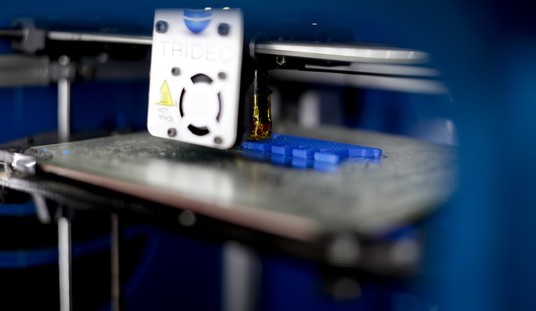As most Bearing Arms readers are probably aware by now, EP Armory—and later Ares Armor—were both raided on the pretense that an injection-molded plastic part created by EP Armory and sold by both companies constitutes a firearm in the eyes of the ATF that has been illegally sold.
The bit of polymer above is that part.
The Firearms Technology Branch (FTB) sent a letter to EP Armory letter (PDF) which argues that the EP Armory part is a firearm receiver, and therefore, their sale by EP Armory and Ares Armor constitutes illegal sales of firearms under the Gun Control Act of 1968.
How did they determine this?
First, the FTB initially claimed that the beige(ish) part in the center of the EP Armory part (pictured more clearly below) was created after the injection molded part (the clear polymer), resulting in the creation of a firearm that wasn’t undone by the injection of the beige(ish) nylon into the fire control group area, which EP Armory calls the “biscuit.”
The FTB claim was that EP Armory created what they viewed as clearly a firearm receiver, and then tried to cheat the system by backfilling it with another colored bit of material in the fire control group area to pull a fast one.

EP Armory countered by explaining to the FTB that in their manufacturing process, the “biscuit” is actually created first, and that the rest of the material is then injection-molded around it. There was no void being filled, because the void never existed at any stage of the manufacturing process.
While technically (and rather obviously) true as a fact of the manufacturing process, the FTB is now arguing that the process alone is enough of a deviation from how things have always been done to render it non-compliant.
The FTB’s revised argument is that all previous parts were compliant because regardless of materials used (metals or polymers), they were formed from single pieces of material formed at one time. As the EP Armory lower is made in two parts that makes it obvious to end users how the completed part should be milled, the FTB has determined it to be a firearm. They claim that the biscuit constitutes “indexing,” which they claim has long been enough to rule that a part is indeed a firearm receiver.
This single material requirement is—to the best we can determine—a brand new requirement made after the fact by the FTB, and seemingly shows the arbitrary and flippant nature of the FTB’s rulings.
The second point of contention for the FTB—which they admit they didn’t bother to discuss in their prior communications with EP Armory—is that three raised nubs (two of which are shown below), indexing the selector, hammer, and trigger pin locations also make the part into a firearm.

The FTB had apparently ruled previously on other submitted lowers that indexing occurred if the pin locations were drilled, and so EP Armory addressed this by adding material (instead of taking it away) to these same locations.
EP Armory contends on its Facebook page:
First and foremost this is not over…..
The BATFE has responded to the explanation of the manufacturing process, the bonding techniques and even the past approvals they have given to other manufacturers. It seems the ATF has begun to circle the wagons and dig its heels in. E P Armory is replying again to this most recent dance around determination letter. I for one have never seen a 6 page long determination letter ever.
From here the strong group of attorneys we have gathered to help us in this fight are going over this document and picking it apart. They simply have just expressed that they refuse to have the public see another group of the ATF with mud on the face. They have had no good public media attention lately and certainly this would be another if this was to be deemed a non-firearm AS IT SHOULD.
How will this eventually play out in court? I have no idea.
What I can say beyond the shadow of a doubt is that this battle has exposed the Achilles heel of the FTB, which is that they have never been accountable for creating a clear definition of what constitutes an AR-15 receiver, and what isn’t.
They instead rely upon a arbitrary and ever-changing process of determination letters, based upon manufacturers sending in parts and the FTB determining—in their opinion, on that day, to that FTB examiner, depending on the mood he or she is in at that exact moment—whether a part constitutes a firearm, or not.
It’s rather like pornography.
The FTB won’t clearly define what constitutes a firearm receiver in plain English with a constant, rational, and well-defined set of criteria. Instead, they rely upon a “but I know it when I see it,” definition cloaked in the thinnest veneer of legitimacy.
That veneer is cracking, and if EP Armory’s legal team is successful, it may shatter entirely, and lead to calls for reform of the FTB so that parts manufacturers can comply with a coherent set of rules and regulations not dependent on the whims of unaccountable bureaucrats masquerading as engineers and firearms experts.
The FTB’s addiction to “baby, show me more” determination letters has to end.










Join the conversation as a VIP Member